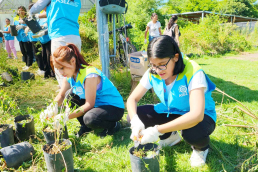The 2030 agenda states that sustainable development is impossible without peace, and that it will be committed to realizing a just society that is safe from fear and violence.
No one can be free from crime in everyday life, so preventing and reducing crime and violence is essential for human well-being and sustainable development. Preventing and reducing crime which violates human life and quality of life, requires everyone’s attention and efforts as much as climate change.
ASEZ is carrying out the “RCT Reporters” activity to share crime situations in each region, inform the necessity of this activity, and encourage stakeholders to participate in it.
In November and December, ASEZ members from about 20 universities in Korea, including Yonsei University, Ewha Womans University, Pusan National University, Kyungpook National University, and Chungnam National University, visited their own campuses and the areas around them to investigate where crime prevention and reduction activities are needed.
Many members picked the alleys around studios as the area with a high risk of crime; this area was dark and had many CCTV blind spots with a small floating population. In addition, it turned out that missing cases frequently occurred in delivery houses at student dormitories.
In order to plan and implement activities that can cope with this crisis, the members sought out crime prevention activities held by local governments across the country.
They sought out Crime Prevention Through Environmental Design [CPTED] cases, such as “Let’s Make a Good and Safe Neighborhood” in Seoul, “Lighthouse Returns to Downtown” in Daejeon, and “Firefly Safe Zone” in Gumi, and researched participatory events, such as “Talent Donation by University Students,” “Cultural Activities for Youths,” “Write Good Comments Campaign,” and “Urban Project Contest.” They analyzed how much these projects contributed to reducing the fear of crime, cultivating community attachment, and preventing crimes. They also looked for the limitations of each project and found ways to compensate for them. Diverse supportive policies were needed, such as constant involvement of government and city, budget expansion, and investment in education. In the case of CPTED, in particular, the lack of follow-ups and public relations activities was pointed out as a problem in most cases. On top of that, social indifference was pointed out as one of the important reasons that the necessity of crime prevention and reduction activities failed to be publicized.
As for university students, it was suggested that they could contribute to solving these issues by encouraging many students to implement joint actions by strengthening regional partnerships. As a specific example, Sungshin Women’s University has been installing security devices, expanding patrol areas under the jurisdiction, and inspecting security weak spots around campus by cooperating with local police stations and building owners in students’ residential areas. ASEZ members also visited local police stations to which each university belongs and had a meeting with police officers to discuss how they would work together, sharing opinions on activating local crime prevention and reduction activities.

Human life, the future, and safety are inseparable. If the safety of citizens, who make up society, is not guaranteed, all the social and economic systems and welfare policies in the world will be useless.
We can protect citizens from crime and violence when we pay attention to crime prevention and reduction and take action for it, and this will change all social frameworks.
The continuous cooperation and participation of many stakeholders, such as public institutions, universities, local residents, and merchants, will strengthen community ties and help all members keep their eye on the community and protect each other.
– CPTED is the abbreviation of Crime Prevention Through Environmental Design. It is a technique to prevent crime through urban and architectural design.













